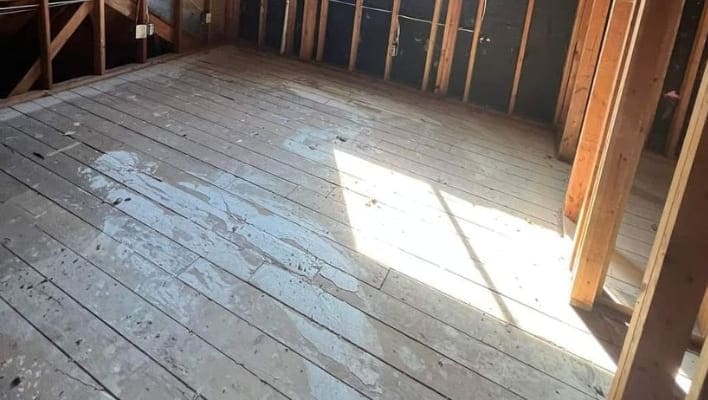Businesses and individuals who work in automotive painting, woodworking, or other industries that require a controlled environment for spraying or painting projects need – a professional paint booth. Creating a professional paint booth can be a game-changer, allowing optimal painting conditions, protecting workers health, and ensures high-quality finishes.
To build a DIY paint booth outside, you need to adhere to safety standards, use proper equipment, and plan carefully. In this article, we will provide a step-by-step guide on how to build a professional paint booth, ensuring a safe and efficient workspace. So, get ready to create an environment that ensures clean airflow, optimal lighting, and superior safety measures. Discover the secrets to building the paint booth of your dreams!
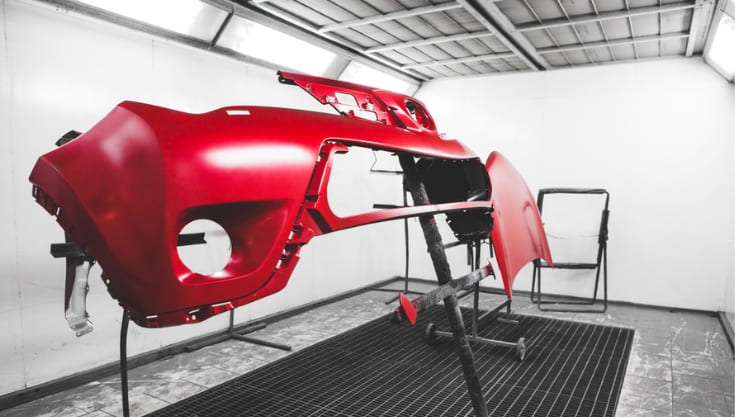
Table of Contents
- How To Build A Paint Booth?
- Step 1: Determine the Requirements
- Step 2: Design and Layout
- Step 3: Choose a suitable location
- Step 4: Construct the Enclosure
- Step 5: Ventilation System
- Step 6: Air Filtering
- Dry Filter vs Water Wash Spray Booths
- Bench Spray Paint Booths | Paint booth for Cabinets & Furniture
- Step 7: Fire Suppression System
- Step 8: Electrical Considerations
- Step 9: Safety Equipment
- Step 10: Testing and Inspection
- How to build a paint booth exhaust system?
- Step 1: Determine Exhaust Requirements
- Step 2: Choose an Exhaust Fan
- Step 3: Position the Fan
- Step 4: Install Ductwork
- Step 5: Include a Damper and Filter
- Step 6: Outdoor Exhaust
- Step 7: Test the System
- Step 8: Regular Maintenance
- how paint booth works?
- Types of paint booth
- Small Homemade paint booth Vs Professional Paint Booth
- Conclusion:
- FAQS On DIY Paint Booth
- Can you build my own paint booth?
- What is needed to build a paint booth?
- What is the best paint booth temperature?
- Is it safe to use LED lights in paint booths?
- What makes a good paint booth?
- What are paint booth walls made of?
- How long is a paint booth for cars?
How To Build A Paint Booth?
A well-designed paint booth provides a controlled environment that minimizes contaminants, ensures proper ventilation, and enhances safety. I will guide you through the step-by-step process of building a professional paint booth in this guide.
- Determine the Requirements
- Design and Layout
- Choose a suitable location
- Construct the Enclosure
- Ventilation System
- Air Filtering
- Fire Suppression System
- Electrical Considerations
- Safety Equipment
- Testing and Inspection
Step 1: Determine the Requirements
Defining your specific requirements is essential before moving forward with the construction process. You should also consider the size of the items to be painted, the type of paint or finish used, ventilation needs, and any local regulations. Taking these factors into consideration will help you design a paint booth that meets your needs and safety standards.
Step 2: Design and Layout
Plan the layout and design of your paint booth in detail. Lighting, electrical outlets, and airflow requirements should all be considered in the design. Make sure your workplace is clean and safe by installing features such as a fire suppression system, an exhaust fan, and a filtration system.
Step 3: Choose a suitable location
Find a suitable location for your paint booth. The area should be adequately ventilated, free of ignition sources, and in accordance with all local zoning regulations. Personnel and equipment need ample space around the booth for movement.
Step 4: Construct the Enclosure
Make your paint booth enclosure with fire-resistant materials like metal panels or fire-rated drywall. It is important to seal the walls, ceiling, and flooring properly to prevent air leaks. Make sure the lighting fixtures you install are explosion-proof and meet safety standards.
Step 5: Ventilation System
Maintain a clean and safe environment by installing a ventilation system that removes hazardous fumes. The ventilation system should include an intake fan, exhaust fan, and a system for supplying filtered air. Consult an HVAC professional to determine the required airflow capacity for your paint booth.
NFPA 33 document, Chapter 5, provides important information regarding the design and construction of spray paint operations. Taking into account the booth’s location and purpose, this section offers examples and exemptions for materials that can be used to construct a spray booth.
In addition, it provides guidelines for placing the spray booth in relation to other operations within the same building. It is essential to adhere to these requirements in order to ensure safe operation of the spray booth, as well as to facilitate easy maintenance and filter replacement. Using the guidelines in this chapter, operators can develop a well-designed and compliant spray booth that promotes safety and efficiency.
Step 6: Air Filtering
The paint booth should be equipped with an air filtration system to prevent contaminants from entering. The Two-stage filtration systems consist of pre-filters and high-efficiency filters. Keeping your filters clean and replacing them regularly is crucial to their effectiveness.
Helpful Resource: Find out how to remove spray paint odors from your home or work environment.
Dry Filter vs Water Wash Spray Booths
Water wash and dry filter systems are the two types of filtration used in professional paint booths.
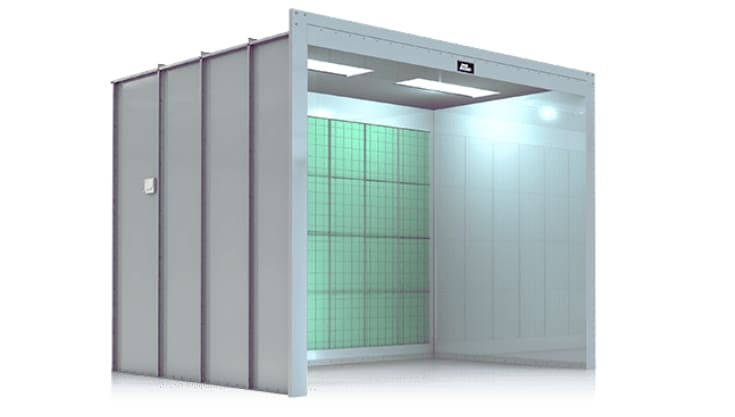
Dry filter spray booths capture overspray particles with layers of dry filters. Filters like these are easy to replace and cost-effective, which makes them suitable for low-to-medium volume operations.

A water cascade or curtain system is used in water wash spray booths to capture overspray. Regular maintenance of the water wash system is necessary to keep the water clean and maintain the filtration system’s efficiency.
The cost and maintenance of water wash booths are higher, but they offer superior overspray capture efficiency and ensure cleaner air indoors. The choice between a dry filter spray booth and a water wash spray booth depends on several factors, including budget, volume of painting projects, and specific industry needs.
You can determine the best filtration system for your paint booth by consulting with a paint booth specialist.
Bench Spray Paint Booths | Paint booth for Cabinets & Furniture
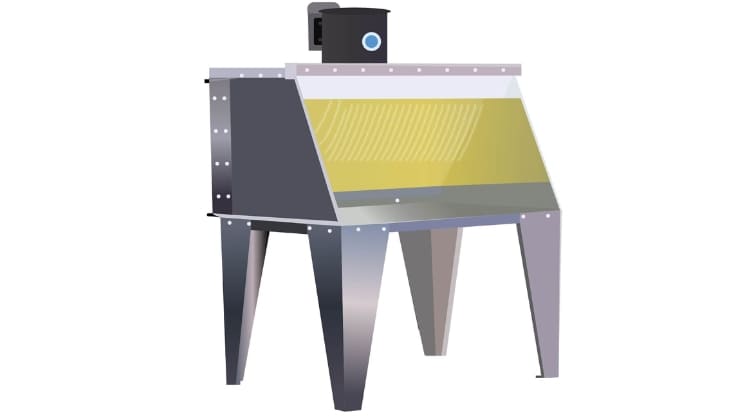
The bench spray paint booth is a portable and compact enclosure designed for smaller painting projects such as furniture, cabinets, or automotive parts. The booths use ventilation systems that capture overspray and remove contaminants. The bench spray paint booth is ideal for DIY enthusiasts, small workshops, and hobbyists who don’t want to install a larger, permanent paint booth.
Step 7: Fire Suppression System
You should install a fire suppression system that meets your local fire codes. There are many ways to prevent fires in paint booths, including automatic sprinklers, fire extinguishers, or specialized suppression systems. Consult a fire safety professional before installing your paint booth system.
Step 8: Electrical Considerations
Install electrical outlets and lighting fixtures in accordance with local electrical codes with the help of a licensed electrician. Protect all electrical components from fire hazards by grounding and protecting them.
Step 9: Safety Equipment
Wear personal protective equipment like respirators, gloves, and safety glasses in your paint booth. Make sure you have access to fire extinguishers and first aid supplies.
Step 10: Testing and Inspection
Once the paint booth is constructed, schedule tests and inspections to ensure that it meets all safety regulations and standards. A professional inspector or an occupational health and safety expert can help you with the evaluation.
How to build a paint booth exhaust system?
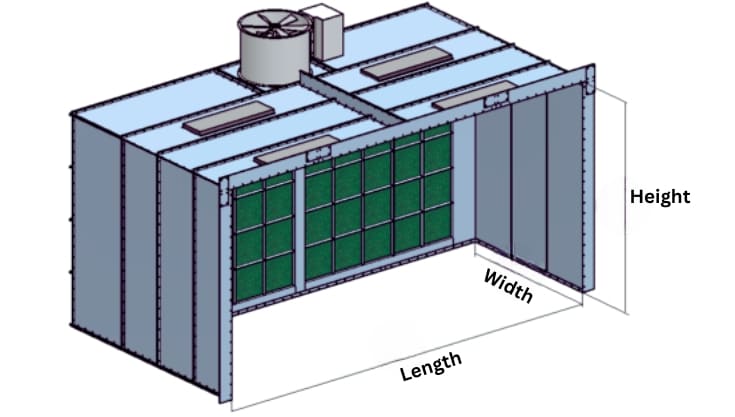
Exhaust systems for paint booths require careful planning and safety regulations. To create an effective and efficient paint booth exhaust system, follow these steps:
Step 1: Determine Exhaust Requirements
Consider the size, type, and local regulations of your paint booth when calculating the required airflow. Then, you can calculate a fan capacity and exhaust duct size.
Step 2: Choose an Exhaust Fan
Choose an exhaust fan that matches your paint booth’s airflow requirements. Ensure the fan is powerful and durable enough to handle continuous operation. Also, consider factors like motor power, noise levels, and fan size, to ensure it meets your specific needs.
Step 3: Position the Fan
Install the exhaust fan in a suitable location outside the paint booth. Ideally, it should be positioned so that it draws out as much air as possible from the booth. For a quiet, vibration-free fan, ensure its secure mounting.
Step 4: Install Ductwork
The exhaust fan should be connected to ductwork to direct air from the booth outside. Use fire-resistant, appropriately sized ducts that comply with local regulations. Maintain smooth airflow by minimizing bends and obstructions in the ducts.
Step 5: Include a Damper and Filter
Adding a damper to the ductwork allows you to adjust airflow when necessary. Consider incorporating filters to capture overspray particles and contaminants before they reach the exhaust fan. Keep the filters clean or replace them regularly to ensure good performance.
Step 6: Outdoor Exhaust
The ductwork should extend to the building’s exterior. Keep the exhaust outlet away from windows, doors, and air intakes to prevent contaminants from entering the building. Also, invest in a weather cap or louvered vent to keep the elements out.
Step 7: Test the System
Test the exhaust system before painting operations. Verify that the airflow is sufficient, the fan runs smoothly, and the ductwork is leak-free. The damper should be adjusted as needed to obtain the desired airflow.
Step 8: Regular Maintenance
Maintain the exhaust system routinely to maintain optimal performance. It includes cleaning or replacing filters, inspecting the fan for wear and damage, and inspecting the ductwork for obstructions or leaks. Using these steps, along with the help of a professional if necessary, you can build an exhaust system for your spray paint booth that is reliable and efficient.
how paint booth works?
A paint booth is an enclosed space designed to control the painting process. It has an exhaust system, walls, a ceiling, and an intake system. Filtered air is pumped into the booth through the intake system. The airflow within the booth plays a crucial role in achieving a quality paint job. This keeps air flowing outward, preventing contaminants from entering the booth. It also keeps dust and dirt from settling on the freshly painted surface.
Simultaneously, the exhaust system removes overspray, fumes, and volatile organic compounds (VOCs) from the booth. You keep the air clean and protect the environment by removing harmful substances through filters or exhaust stacks. Proper airflow, ventilation, and lighting create an optimal working environment for painters, allowing them to create flawless finishes while adhering to safety standards.
Types of paint booth
Paint booths can be divided into four categories: downdraft, crossdraft, semi-downdraft, and side downdraft.
Cross Draft
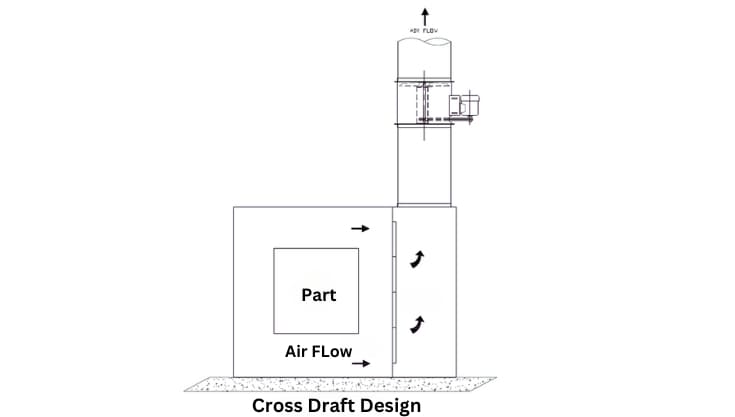
When it comes to paint booth airflow, the cross-draft method is widely used and highly effective. In a cross-draft booth, the air enters through the front of the booth, typically passing through intake filters that capture dirt and contaminants that could mar the paint finish. This filtered air then moves horizontally across the booth towards the rear exhaust chamber. This horizontal flow ensures that the air uniformly covers the painted surface, resulting in a precise and smooth finish.
To achieve this cross-draft airflow, the booth utilizes an intake chamber at the front, where air is drawn in. From there, the air is pushed through the booth along the floor, circulating within the booth space. Lastly, the air is expelled from the booth exhaust system situated at the bottom. This continuous airflow ensures a clean environment and facilitates an optimal paint job, all while providing cost-effective solutions.
By understanding and implementing the cross-draft airflow system, you can create an efficient and productive paint booth that delivers exceptional results.
Downdraft

When it comes to paint booths, the downdraft design is widely regarded as one of the most efficient and effective in terms of contamination and overspray control. In a downdraft paint booth, airflow is directed from the ceiling intake chamber, equipped with filters. It flows downwards over the vehicle being painted. This downward flow ensures that any overspray generated during the spraying process is drawn towards the grating over a pit in the floor.
The overspray, as it passes through the grating, is captured by exhaust filters located beneath. This removal of overspray from the air stream is facilitated by an exhaust fan and ductwork system. Afterwards, clean air is released. Compared to a crossdraft booth, a downdraft booth requires a higher airflow rate but offers superior control over the finishing environment.
The key principle of a downdraft booth is maintaining downward airflow from the ceiling to the floor. This ensures that contaminants and overspray are effectively captured and removed, resulting in a cleaner and more controlled painting environment. By incorporating this downdraft airflow system into your paint booth, you can achieve superior finishes while minimizing contamination risk and maximizing efficiency.
Semi-Downdraft
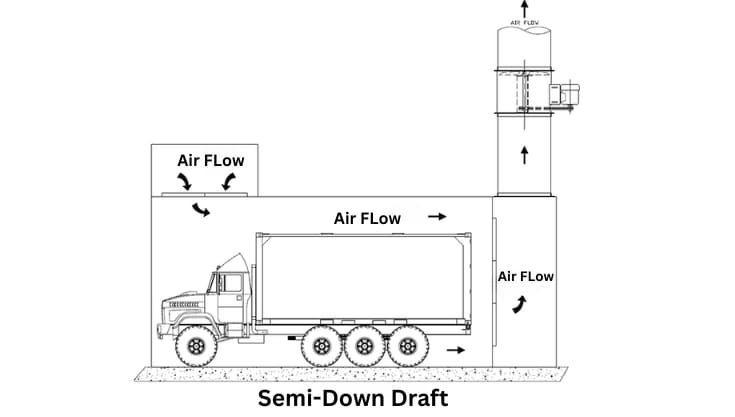
Paint spray booths that create semi-downdrafts offer a controlled environment for painting. Fresh air is drawn from the ceiling of these booths, while overspray is expelled by a filtered exhaust system located at the rear. It captures overspray and minimizes contamination on the painted surface due to the downward and slightly backward airflow pattern. These booths are versatile and can be used for projects of various sizes.
Side Downdraft
The side downdraft spray booth offers effective air flow control for high-quality finishes. They are equipped with ceiling or side wall filters to allow intake air to enter, while the exhaust system is located on the floor or along lower side walls. A downward airflow pattern ensures even distribution across the work area and keeps overspray away from the painter. Side downdraft booths minimize contamination and paint defect risk by capturing overspray. Moreover, they offer efficient ventilation and fume extraction.
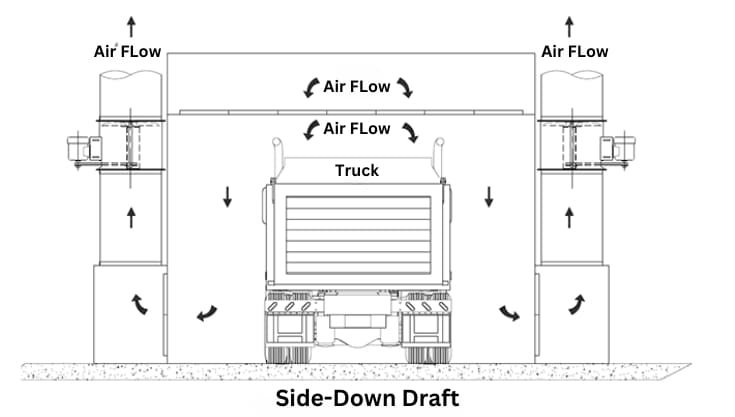
Small Homemade paint booth Vs Professional Paint Booth
A small spray paint booth and a professional paint booth serve the same purpose of providing a controlled environment for painting projects. The two systems differ in size, features, and complexity.
People often ask how to make a small paint booth?
Small spray paint booths are compact enclosures designed for painting smaller items or conducting DIY projects. It may be made of basic materials such as plywood or metal panels and may not have advanced features like ventilation systems or elaborate filtration mechanisms. Small paint booths are often used by hobbyists, DIYers, or individuals with limited space and a budget. For example, you can use a garage, shed, or well ventilated room for a booth.
While professional paint booths are larger, more advanced, and specially built for commercial use. Paint booths designed for professional use meet industry standards and regulations. Overspray filters, advanced lighting, and robust ventilation systems are among the safety features included in these systems. Large-scale industrial painting operations, automotive shops, and industrial manufacturing facilities commonly use paint booths.
A professional paint booth offers greater capacity, improved filtration, and enhanced safety features than a small spray paint booth, but both provide controlled environments for painting. In addition to accommodating larger projects, professional paint booths also meet the demands of commercial applications.
Small spray paint booths and professional paint booths are best suited to specific painting needs, control levels, and budgets. A small spray paint booth may suffice to complete small projects. In contrast, professional paint booths are recommended for larger projects, consistent quality finishes, and compliance with industry standards.
Conclusion:
In conclusion, constructing a homemade or professional paint booth necessitates meticulous planning, a focus on detail, and a commitment to safety standards. By investing the time and effort into building an ideal spray booth, you can create a controlled and secure environment that enhances your painting experience.
It is important to note that when it comes to aspects like fire safety and HVAC systems, consulting professionals is always advisable for specific guidance and expertise. We hope that our comprehensive instructions have provided you with valuable insights and guidance on How to build a professional paint booth. Now, armed with this knowledge, you can elevate your painting endeavors and achieve outstanding results in a space designed specifically for your craft.
Happy painting!
FAQS On DIY Paint Booth
Can you build my own paint booth?
Yes, you can build your own paint booth. The process requires careful planning, knowledge of safety regulations, and adherence to local laws.
What is needed to build a paint booth?
To build a paint booth, you will need several key components. It involves a sturdy booth enclosure made of fire resistant materials, such as metal panels or plywood, a ventilation system that removes fumes and overspray, a clean air supply system, adequate lighting fixtures, and a properly designed airflow system. You may also need an electrician to install electrical wiring and outlets, as well as personal protective equipment (PPE). Constructing a paint booth requires adhering to local codes and safety regulations.
What is the best paint booth temperature?
The ideal temperature for a paint booth is typically set between 70 and 75 degrees Fahrenheit (21 to 24 degrees Celsius) or 5 degrees above the outside temperature, whichever is greater. This means that if the outside temperature is 90 degrees Fahrenheit (32 degrees Celsius) while painting, the paint booth temperature should be set at 95 degrees Fahrenheit (35 degrees Celsius).
Is it safe to use LED lights in paint booths?
LED lights can be used safely in paint booths. A LED light produces minimal heat, reducing the risk of heat-related issues and fire hazards. Additionally, LED lights provide excellent color rendering properties, so painters can see accurately and achieve high-quality paint finishes. As LEDs have a longer lifespan and are energy-efficient, they’re popular for paint booth lighting.
What makes a good paint booth?
There are several essential features of a good paint booth. It should have effective ventilation systems that control airflow and remove fumes and overspray. The visibility of the painting area must be ensured with adequate lighting. A reliable filtration system should also be installed in the booth to capture and eliminate contaminants. It is also important that good paint booths are constructed with fire-resistant materials, meet safety regulations, and comply with industry standards.
What are paint booth walls made of?
The walls of paint booths are usually made of non-combustible materials, such as steel, concrete, or masonry. The properties of these materials include stability, durability, and fire resistance. Walls should be smooth and continuous for easy cleaning and to prevent contaminants from accumulating. Material selection for paint booth walls depends on factors such as budget, booth size, and specific painting requirements.
How long is a paint booth for cars?
The length of a paint booth for cars can vary depending on the specific requirements of the painting operation. Standard-sized automotive paint booths typically range from 24 to 30 feet, 14 feet wide, and 10 feet tall.
This size provides sufficient space for most vehicles and allows for proper airflow and maneuverability during painting. It is important to note that specific projects or larger vehicles may require custom-sized booths to ensure optimal performance. When selecting a paint booth size, consider the dimensions mentioned above or similar sizes. They can be a suitable starting point for most automotive applications.

Martina Hitchcock
Martina Hitchcock is a versatile author with expertise in different fields. As a paint sprayer expert, she has in-depth knowledge of paint spraying techniques, tools, and equipment. Martina is also an experienced home remodeler who has worked on various projects, including kitchen and bathroom renovations, flooring installations, and room additions. Her knowledge of home improvement and remodeling is extensive, and she enjoys sharing her insights and tips with readers. You can follow her on Facebook.

